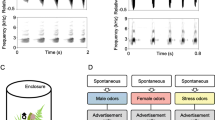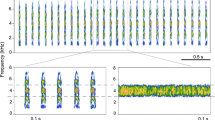Abstract
Many characteristics of signals can convey information, but the exact timing of the signal often matters as well. The timing of signals is shaped by selective pressures including mate preferences, predation, and competition. In many insect communities, male calling to attract females is persistent and pervasive, and signal timing interactions among individuals are relatively common. In Neotropical forests, many katydid species are represented in the acoustic environment, but calls are usually short (<40 ms) and infrequent (<10 s of sound per individual per night), characteristics that have likely evolved in response to intense predation by insectivorous bats. We test two alternative hypotheses about signal timing in environments where signaling is rare and costly, either that timing is absent due to the unpredictable nature of the signals or that the rarity of signals places a premium on signal timing and attention to the acoustic environment. We tested these hypotheses by broadcasting conspecific calls, heterospecific calls, and silence to eight species of katydids and measuring calling activity and call timing in each playback treatment. All species changed the amount or timing of calling (or both) as a result of the playbacks, but species responded differently to playbacks, with some calling more or less during specific treatments and some showing differences in the timing of calls relative to playbacks. Although short latency signal timing was not observed, this study shows that Neotropical forest katydids are responsive to their acoustic environment despite an exceptionally low rate of signaling.
Significance statement
In many species, males produce signals to attract females, and studies show that the timing of these signals relative to other stimuli can play an important role in mate attraction and predator avoidance. Most of these studies have investigated species that are prolific signalers, due to the ease of collecting data. Here, we extend these theories and test them in Neotropical forest katydids, which produce very short and sporadic acoustic signals. We find that these insects do not display the fast competitive interactions seen in more prolific signalers, but still adjust both the timing and amount of calling in response to what they hear. These findings reveal that insects that signal rarely are still attending to the signaling of others and that their behavior can be strongly affected by the signals of other insects, including insects of other species.





Similar content being viewed by others
References
Alem S, Koselj K, Siemers BM, Greenfield MD (2011) Bat predation and the evolution of leks in acoustic moths. Behav Ecol Sociobiol 65:2105–2116
Bailey WJ (2003) Insect duets: underlying mechanisms and their evolution. Physiol Entomol 28:157–174
Bailey W, Macleay C, Gordon T (2006) Acoustic mimicry and disruptive alternative calling tactics in an Australian bushcricket (Caedicia; Phaneropterinae; Tettigoniidae; Orthoptera): does mating influence male calling tactic? Physiol Entomol 31:201–210
Belwood JJ (1988) The influence of bat predation on calling behavior in neotropical forest katydids (Insecta: Orthoptera: Tettigoniidae). PhD Thesis, University of Florida
Belwood JJ, Morris GK (1987) Bat predation and its influence on calling behavior in neotropical katydids. Science 238:64–67
Brumm H (2006) Signalling through acoustic windows: nightingales avoid interspecific competition by short-term adjustment of song timing. J Comp Physiol A 192:1279–1285
Burkard R (2006) Calibration of acoustic transients. Brain Res 1091:27–31
Colavita FB (1974) Human sensory dominance. Percept Psychophys 16:409–412
Coleman SW (2008) Mourning dove (Zenaida macroura) wing-whistles may contain threat-related information for con-and hetero-specifics. Naturwissenschaften 95:981–986
Del Castillo R, Gwynne D (2007) Increase in song frequency decreases spermatophore size: correlative evidence of a macroevolutionary trade-off in katydids (Orthoptera: Tettigoniidae). J Evol Biol 20:1028–1036
Diwakar S, Balakrishnan R (2007a) The assemblage of acoustically communicating crickets of a tropical evergreen forest in southern India: call diversity and diel calling patterns. Bioacoustics 16:113–135
Diwakar S, Balakrishnan R (2007b) Vertical stratification in an acoustically communicating ensiferan assemblage of a tropical evergreen forest in southern India. J Trop Ecol 23:479–486
Dyson ML, Henzi SP, Passmore NI (1994) The effect of changes in the relative timing of signals during female phonotaxis in the reed frog, Hyperolius marmoratus. Anim Behav 48:679–685
Eades D, Otte D, Cigliano M, Braun H (2016) Orthoptera species file online. Version 2.0/4.0 [WWW document]. URL http://Orthoptera.SpeciesFile.org
Falk JJ, ter Hofstede HM, Jones PL, Dixon MM, Faure PA, Kalko EK, Page RA (2015) Sensory-based niche partitioning in a multiple predator–multiple prey community. Proc R Soc Lond B Biol Sci 282:20150520
Geissmann T (2002) Duet-splitting and the evolution of gibbon songs. Biol Rev Camb Philos Soc 77:57–76
Gerhardt HC, Huber F (2002) Acoustic communication in insects and anurans: common problems and diverse solutions. University of Chicago Press, Chicago
Grafe TU (1996) The function of call alternation in the African reed frog (Hyperolius marmoratus): precise call timing prevents auditory masking. Behav Ecol Sociobiol 38:149–158
Greenfield MD (1983) Unsynchronized chorusing in the coneheaded katydid Neoconocephalus affinis (Beauvois). Anim Behav 31:102–112
Greenfield MD (1994) Cooperation and conflict in the evolution of signal interactions. Annu Rev Ecol Syst:97–126
Greenfield MD (2005) Mechanisms and evolution of communal sexual displays in arthropods and anurans. Adv Study Behav 35:1–62
Greenfield MD, Roizen I (1993) Katydid synchronous chorusing is an evolutionarily stable outcome of female choice. Nature 364:618–620
Greenfield MD, Tourtellot MK, Snedden WA (1997) Precedence effects and the evolution of chorusing. Proceedings of the Royal Society of London. Series B: Biological Sciences 264:1355–1361
Gwynne DT (2001) Katydids and bush-crickets: reproductive behavior and evolution of the Tettigoniidae. Cornell University Press, New York
Gwynne DT, Bailey WJ (1988) Mating system, mate choice and ultrasonic calling in a zaprochiline katydid (Orthoptera: Tettigoniidae). Behaviour 105:202–223
Hartbauer M, Kratzer S, Steiner K, Römer H (2005) Mechanisms for synchrony and alternation in song interactions of the bushcricket Mecopoda elongata (Tettigoniidae: Orthoptera). J Comp Physiol A 191:175–188
Heller K, Hemp C (2014) Fiddler on the tree—A bush-cricket species with unusual stridulatory organs and song.
Heller K, von Helversen D (1986) Acoustic communication in phaneropterid bushcrickets: species-specific delay of female stridulatory response and matching male sensory time window. Behav Ecol Sociobiol 18:189–198
Heller K, Hemp C, Ingrisch S, Liu C (2015) Acoustic communication in Phaneropterinae (Tettigonioidea)—a global review with some new data. J Orthop Res 24:7–18
Henry CS, Wells MM (2010) Acoustic niche partitioning in two cryptic sibling species of Chrysoperla green lacewings that must duet before mating. Anim Behav 80:991–1003. doi:10.1016/j.anbehav. 2010.08.021
Höbel G (2010) Interaction between signal timing and signal feature preferences: causes and implications for sexual selection. Anim Behav 79:1257–1266
Höbel G, Gerhardt HC (2007) Sources of selection on signal timing in a tree frog. Ethology 113:973–982
Kalka M, Kalko EK (2006) Gleaning bats as underestimated predators of herbivorous insects: diet of Micronycteris microtis (Phyllostomidae) in Panama. J Trop Ecol 22:1–10
Klump GM, Gerhardt HC (1992) Mechanisms and function of call-timing in male-male interactions in frogs. In: Playback and studies of animal communication. Springer, New York, pp. 153–174
Lang AB, Kalko EK, Römer H, Bockholdt C, Dechmann DK (2006) Activity levels of bats and katydids in relation to the lunar cycle. Oecologia 146:659–666
Lehmann GU (2003) Review of biogeography, host range and evolution of acoustic hunting in Ormiini (Insecta, Diptera, Tachinidae), parasitoids of night-calling bushcrickets and crickets (Insecta, Orthoptera, Ensifera). Zoologischer Anzeiger-A Journal of Comparative Zoology 242:107–120
Lloyd JE (1984) Evolution of a firefly flash code. Fla Entomol:228–239
Magrath RD, Haff TM, Fallow PM, Radford AN (2015) Eavesdropping on heterospecific alarm calls: from mechanisms to consequences. Biol Rev 90:560–586
Mennill DJ, Burt JM, Fristrup KM, Vehrencamp SL (2006) Accuracy of an acoustic location system for monitoring the position of duetting songbirds in tropical forest. J Acoust Soc Am 119:2832–2839. doi:10.1121/1.2184988
Montealegre-Z F (2009) Scale effects and constraints for sound production in katydids (Orthoptera: Tettigoniidae): correlated evolution between morphology and signal parameters. J Evol Biol 22:355–366
Montealegre-Z F, Morris GK (1999) Songs and systematics of some Tettigoniidae from Colombia and Ecuador I. Pseudophyllinae (Orthoptera). Journal of Orthoptera Research:163–236
Montealegre-Z F, Morris GK, Mason AC (2006) Generation of extreme ultrasonics in rainforest katydids. J Exp Biol 209:4923–4937. doi:10.1242/jeb. 02608
Morris GK (1980) Calling display and mating behaviour of Copiphora rhinoceros Pictet (Orthoptera: Tettigoniidae). Anim Behav 28:42–IN1
Morris G, Mason A, Wall P, Belwood J (1994) High ultrasonic and tremulation signals in neotropical katydids (Orthoptera: Tettigoniidae). J Zool 233:129–163
Nickle DA, Quintero D, Aiello A (1992) Katydids of Panama (Orthoptera: Tettigoniidae) insect of Panama and Mesoamerica. Oxford Science Publications:142–184
Phelps SM, Rand AS, Ryan MJ (2007) The mixed-species chorus as public information: túngara frogs eavesdrop on a heterospecific. Behav Ecol 18:108–114
R Core Team (2015) R: a language and environment for statistical computing. R Foundation for Statistical Computing, Vienna, Austria. ISBN 3–900051–07-0, URL http://www. R-project. org/
Rentz D (1975) Two new katydids of the genus Melanonotus from Costa Rica with comments on their life history strategies (Tettigoniidae: Pseudophyllinae). Entomol News 86:129–140
Rodriguez RL, Cocroft RB (2006) Divergence in female duetting signals in the Enchenopa binotata species complex of treehoppers (Hemiptera: Membracidae). Ethology 112:1231–1238
Romer H (1993) Environmental and biological constraints for the evolution of long-range signalling and hearing in acoustic insects philosophical transactions of the Royal Society B. Biological Sciences 340:179–185
Romer H, Lewald J (1992) High-frequency sound transmission in natural habitats: implications for the evolution of insect acoustic communication. Behav Ecol Sociobiol 29:437–444
Romer H, Lang A, Hartbauer M (2010) The signaller’s dilemma: a cost-benefit analysis of public and private communication. PLoS One 5:e13325. doi:10.1371/journal. pone.0013325
Ryan MJ, Tuttle MD, Taft LK (1981) The costs and benefits of frog chorusing behavior. Behav Ecol Sociobiol 8:273–278
Sarria-S F, Morris G, Windmill J (2014) Shrinking wings for ultrasonic pitch production: hyperintense ultra-short-wavelength calls in a new genus of neotropical katydids. Tettigoniidae, Orthoptera
Shaw KC, Galliart P (1987) Acoustic and mating behavior of a Mexican katydid, Pterophylla beltrani (Orthoptera: Tettigoniidae). Fla Entomol:354–368
Siegert ME, Romer H, Hashim R, Hartbauer M (2011) Neuronal correlates of a preference for leading signals in the synchronizing bushcricket Mecopoda elongata (Orthoptera, Tettigoniidae). J Exp Biol 214:3924–3934. doi:10.1242/jeb. 057901
Snedden W, Greenfield MD (1998) Females prefer leading males: relative call timing and sexual selection in katydid choruses. Anim Behav 56:1091–1098
Symes L, Ayres M, Cowdery C, Costello R (2015) Signal diversification in Oecanthus tree crickets is shaped by energetic, morphometric, and acoustic trade-offs. Evolution 69:1518–1527
ter Hofstede HM, Kalko EKV, Fullard JH (2010) Auditory-based defence against gleaning bats in neotropical katydids (Orthoptera: Tettigoniidae). J Comp Physiol A 196:349–358
Tobias JA, Planque R, Cram DL, Seddon N (2014) Species interactions and the structure of complex communication networks. Proc Natl Acad Sci U S A 111:1020–1025. doi:10.1073/pnas.1314337111
Walker TJ, Moore TE (2013) Singing insects of North America. University of Florida. http://entnemdept.ifas.ufl.edu/walker/Buzz/crickets.htm
Acknowledgments
Funding and logistical support was provided by the Smithsonian Tropical Research Institute to LBS and RAP and by Dartmouth College to HMtH. Full permits for the project were obtained through the Smithsonian Tropical Research Institute. Thank you to L. Höger for assistance with data analysis. Thank you to the staff at Barro Colorado Island for logistical and administrative support.
Author information
Authors and Affiliations
Corresponding author
Additional information
Communicated by D. Gwynne
Electronic Supplementary Materials
Supplemental Fig. 1
(DOCX 1553 kb)
Supplemental Fig. 2
(DOCX 41 kb)
Supplemental Fig. 3
(DOCX 142 kb)
Supplemental Table 1
(DOCX 14 kb)
Supplemental Table 2
(DOCX 15 kb)
Supplemental Table 3
(DOCX 17 kb)
Rights and permissions
About this article
Cite this article
Symes, L.B., Page, R.A. & ter Hofstede, H.M. Effects of acoustic environment on male calling activity and timing in Neotropical forest katydids. Behav Ecol Sociobiol 70, 1485–1495 (2016). https://doi.org/10.1007/s00265-016-2157-4
Received:
Revised:
Accepted:
Published:
Issue Date:
DOI: https://doi.org/10.1007/s00265-016-2157-4




